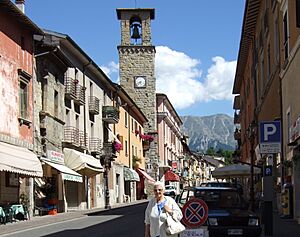Amatrice facts for kids
Quick facts for kids
Amatrice
|
||
|---|---|---|
| Comune di Amatrice | ||

|
||
|
||
 |
||
| Country | Italy | |
| Region | Lazio | |
| Province | Rieti (RI) | |
| Frazioni | see list | |
| Area | ||
| • Total | 174 km2 (67 sq mi) | |
| Elevation | 955 m (3,133 ft) | |
| Demonym(s) | Amatriciani | |
| Time zone | UTC+1 (CET) | |
| • Summer (DST) | UTC+2 (CEST) | |
| Postal code |
02012
|
|
| Dialing code | 0746 | |
| Patron saint | Filetta's Madonna | |
| Saint day | Ascension Day | |
Amatrice is a town and comune (which means municipality or local government area) in the Lazio region of Italy. It is located in the Province of Rieti. This town is known for its food and farming, especially because it's in the Gran Sasso e Monti della Laga National Park area.
Sadly, Amatrice was hit very hard by a powerful earthquake on August 24, 2016. Despite this, it is still recognized as one of "The most beautiful villages of Italy" (I Borghi più belli d'Italia).
Contents
A Look at Amatrice's Past
Archaeologists have found signs that people lived in the Amatrice area a very long time ago, even before recorded history. Remains of ancient Roman buildings and tombs have also been discovered here.
How Amatrice Grew in Medieval Times
After the Western Roman Empire fell, the Amatrice area became part of a region controlled by the Lombards, called the Duchy of Spoleto. The town of Matrice (an older name for Amatrice) was first mentioned in old documents in 1012. These papers said it was important because it was located where the Tronto and Castellano rivers meet.
In 1265, Amatrice became part of the Kingdom of Naples. Later, when a new family called the Angevins took over Naples, Amatrice tried to break free. However, Charles I of Anjou defeated them in 1274. Even so, Amatrice managed to keep some independence as an universitas, which meant it had its own local government.
During the 1300s and 1400s, Amatrice often had disagreements with nearby towns like Norcia and L'Aquila. Its soldiers even helped in a big battle to take over L'Aquila. The town also supported Naples during a conflict over who would rule the Kingdom of Naples.
The beautiful Church of Sant'Agostino (shown on the left) was built in 1428. In 1529, an army general named Philibert of Chalon attacked Amatrice. He was working for Emperor Charles V. The emperor then gave Amatrice to his general, Alessandro Vitelli.
The city suffered a lot of damage from an earthquake in 1639. Later, powerful families like the Orsini and the Medici from Florence controlled Amatrice until 1737.
Amatrice in Modern Times
After Italy became one united country in the 1800s, Amatrice was first part of the L'Aquila province. Then, in 1927, it became part of the Lazio region, where it is today.
On August 24, 2016, a very strong earthquake hit Amatrice. This natural disaster caused a lot of damage to the town. Many buildings were destroyed, and sadly, many people lost their lives. The mayor at the time, Sergio Pirozzi, said that "three-quarters of the town was destroyed." Nearby towns like Accumoli were also badly affected.
Historic Buildings of Amatrice
Many old and important buildings in Amatrice have a rich history. Here's a look at some of them and how they were affected by the 2016 earthquake:
| Building | Completed | Status | Additional notes |
|---|---|---|---|
| Civic tower | 13th century | ‡ | This tower stood strong during the earthquake. |
| Church of Sant'Agostino | 1428 | † | This church had a beautiful Gothic entrance and old paintings. Sadly, parts of its roof and front wall collapsed during the earthquake. |
| Church of Sant'Emidio | 15th century | † | |
| Church of San Francesco | late 14th century | This church features a marble Gothic entrance and 15th-century paintings in its apse (the rounded end of the church). | |
| Church of Santa Maria Porta Ferrata | † | ||
| Gothic church | † | Located in the small village of San Martino. | |
| Sanctuary of Madonna delle Grazie | 15th century | † | This sanctuary is believed to be built where an ancient Roman villa once stood. |
| Sanctuary of Icona Passatora | late 15th century | † | Located in the small village of Ferrazza. |
| Oratory of Santa Maria di Loreto | late 16th century | † | Located in the small village of Rio. |
‡ Withstood the 2016 earthquake
† Did not withstand the earthquake
Famous Food from Amatrice

Amatrice is very famous for a special pasta sauce called sugo all'amatriciana. This tasty sauce is usually served with long pasta shapes like spaghetti, bucatini, or rigatoni. It's a popular story that many cooks who worked for the popes throughout history came from Amatrice!
Notable People from Amatrice
Many interesting people have come from Amatrice, including:
- Nicola Filotesio (1480 or 1489–1547 or 1559), a talented Italian painter, architect, and sculptor from the Renaissance period.
- Giovanni Domenico Roberto Minozzi (1884-1959), an Italian Roman Catholic priest who started a national organization for southern Italy.
- Elio Augusto Di Carlo (1918–1998), an Italian expert on birds (ornithologist), historian, and doctor.
- Sara Pichelli (born 1983), a well-known artist.
What are Frazioni?
Frazioni are like small villages or hamlets that belong to a larger municipality or town. Amatrice has many of these smaller communities. Some of them include Aleggia, Bagnolo, Capricchia, and many others, like Rio and Saletta.



